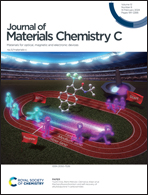Adaptive coloration enabled by the reversible osmotic annealing of chromatophore-like microcapsules†
Abstract
Nature's diverse creatures have evolved sophisticated mechanisms via molecules and nanostructures, yielding dynamic and brilliant biological color transformations. Inspired by these systems, we generate a dynamic soft system that facilitates reversible selection between predominately pigment or structure based mechanisms of coloration via actuation through changes in the osmotic pressure. To achieve this, we use microfluidics to prepare double emulsion capsules which encapsulate polystyrene nanoparticles functionalized with xanthommatin, a biochrome. This system enables controlled modulation between color mechanisms through pigment loading density and osmotic stress manipulation, offering finely tuned color changes in the double emulsion capsules. We further investigate the relationship between these two coloration mechanisms by comparing the reflectance spectra of chromatophore-like capsules and demonstrate a material system that can house the capsules and elicit bulk color changes. Our results highlight a unique and potentially scalable approach for fabricating color-changing materials that provide access to a broad range of tunable visible colors.



 Please wait while we load your content...
Please wait while we load your content...